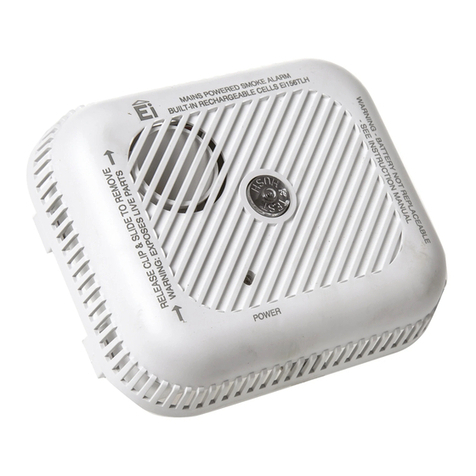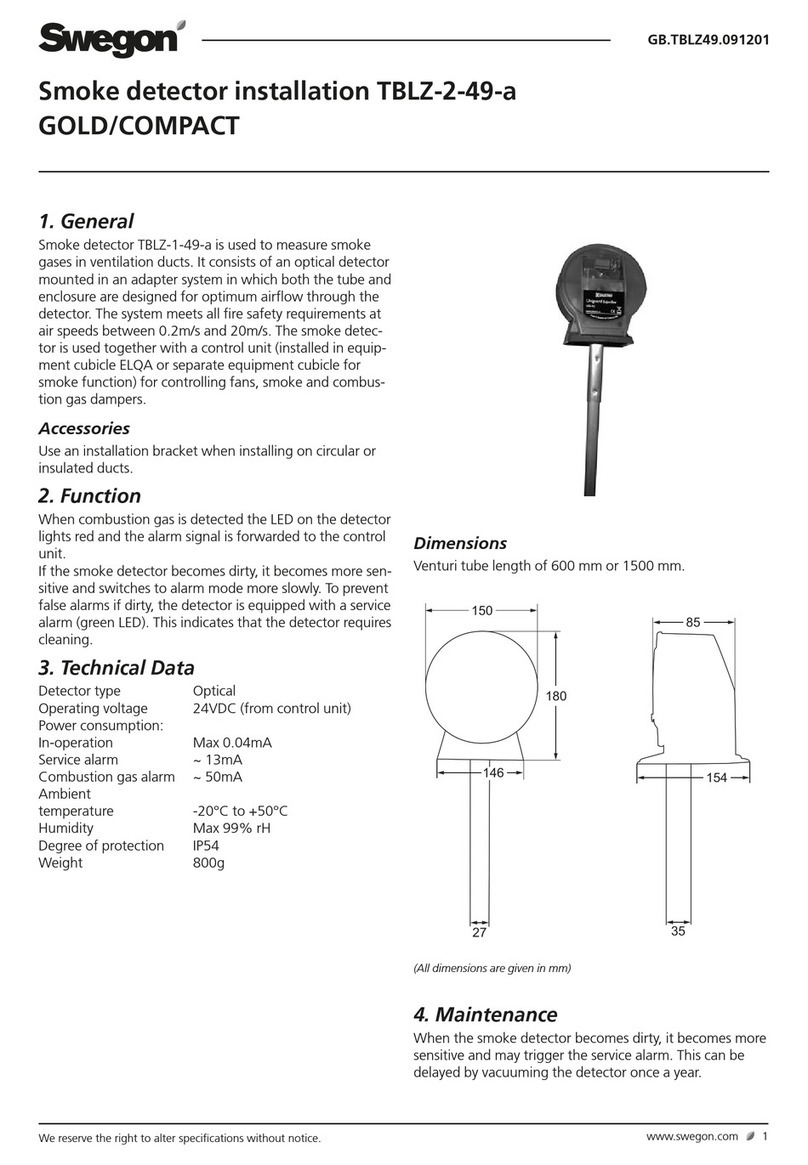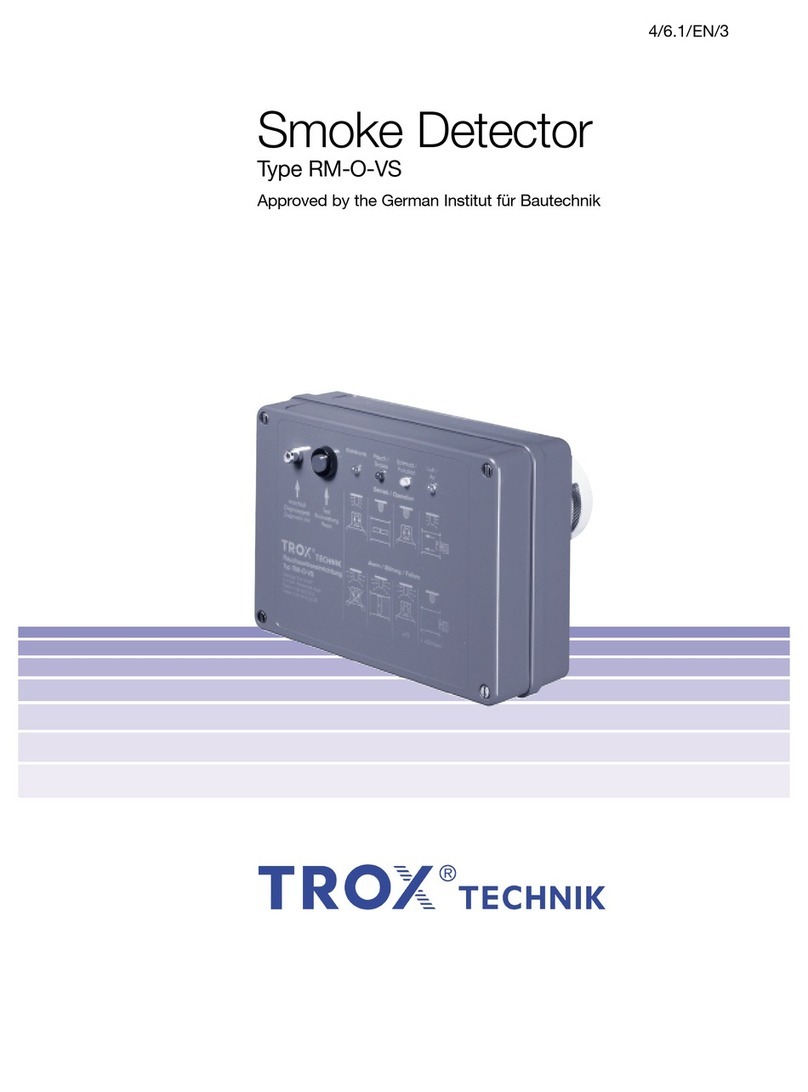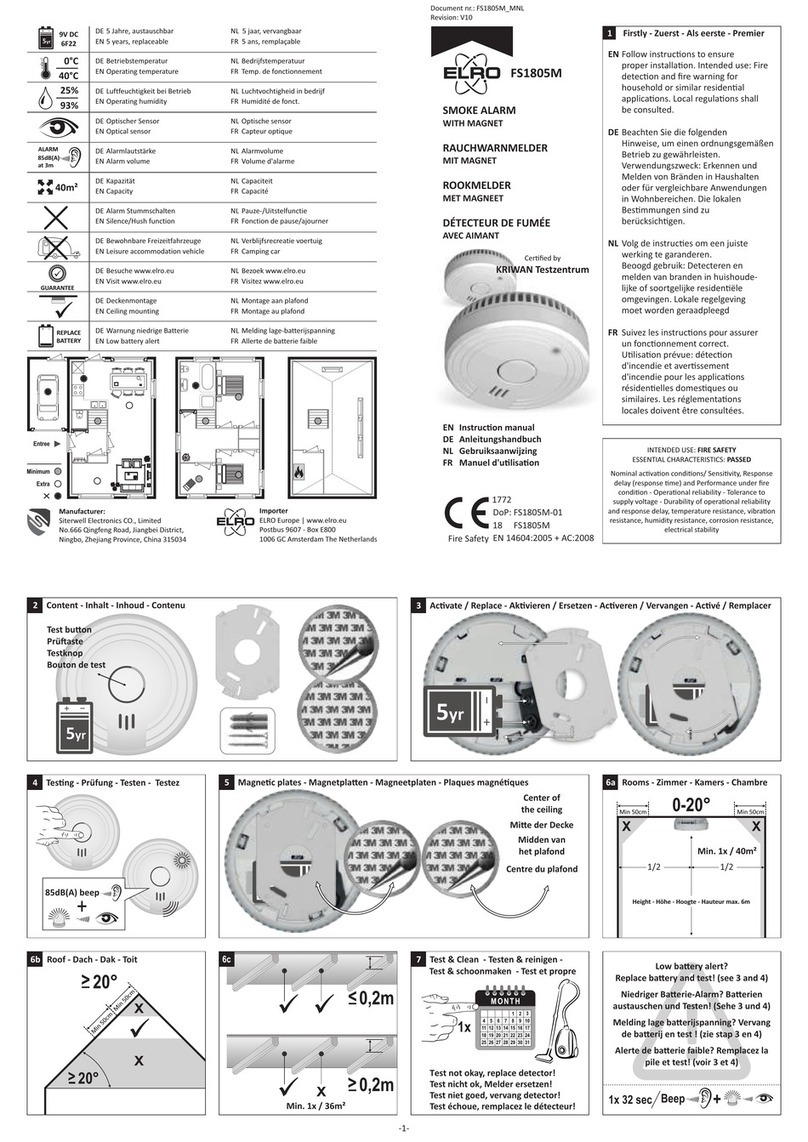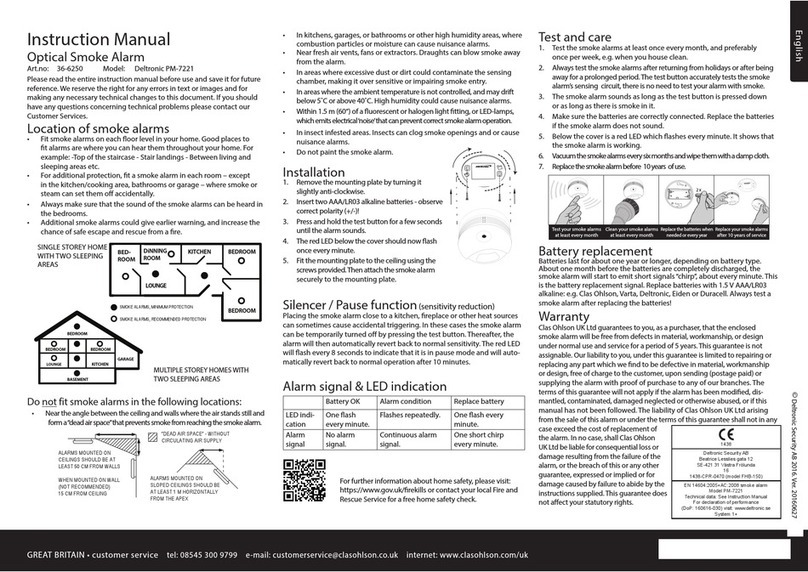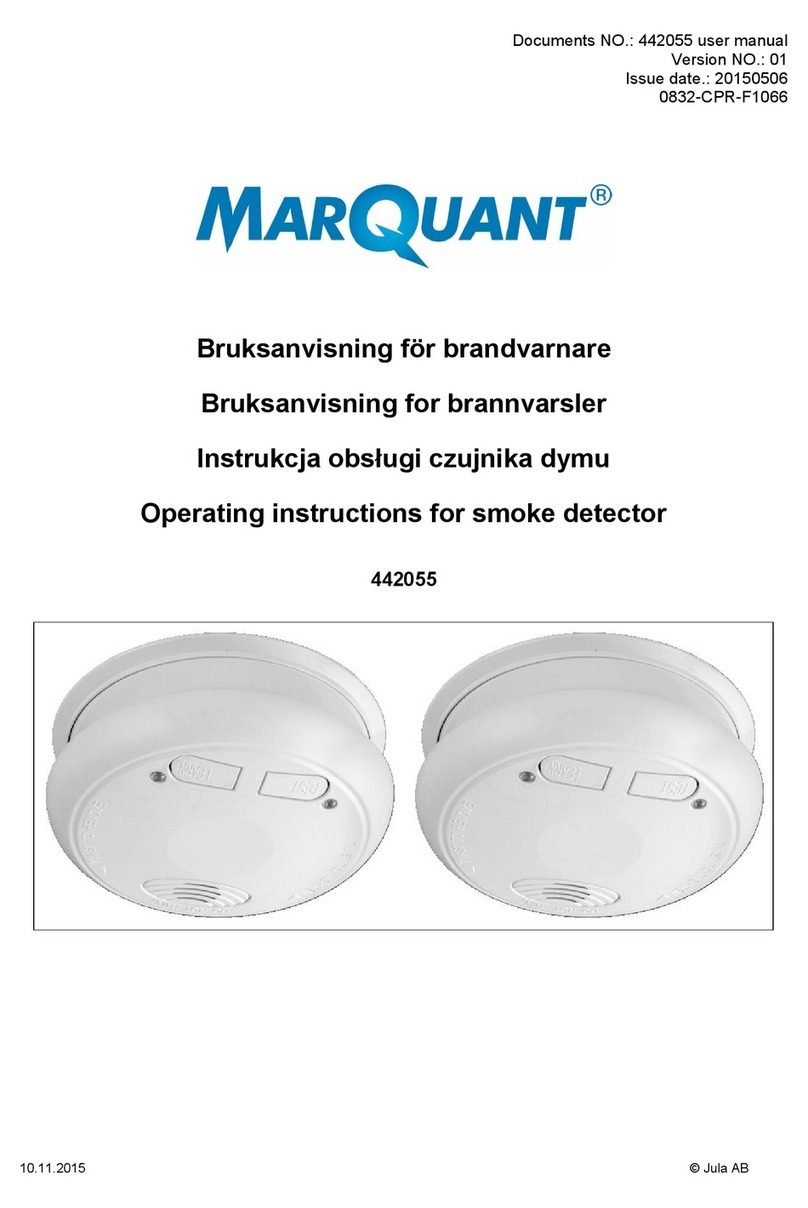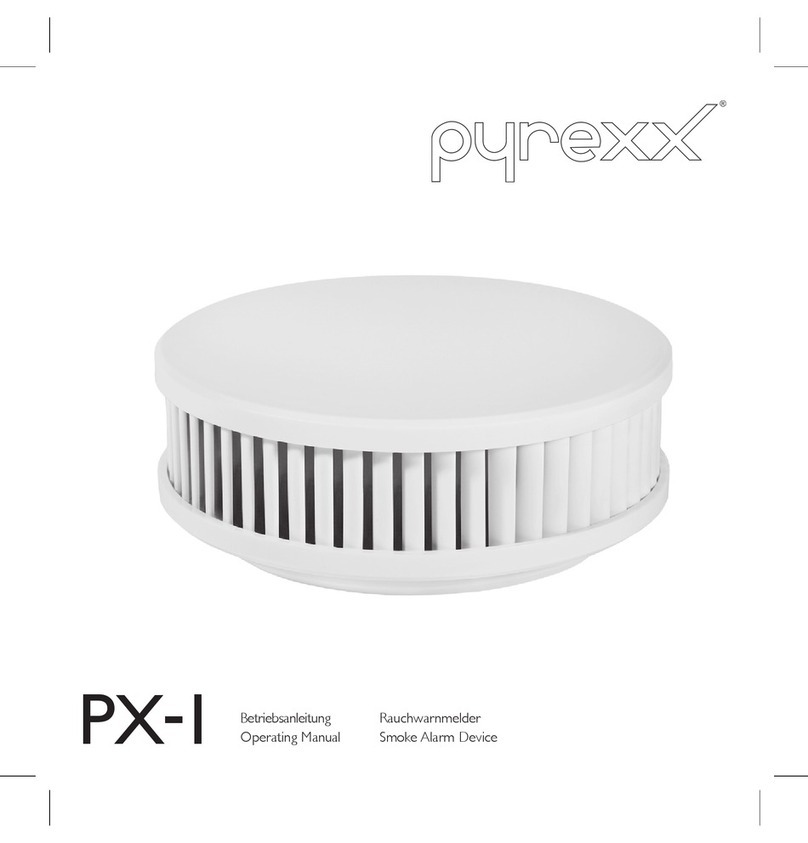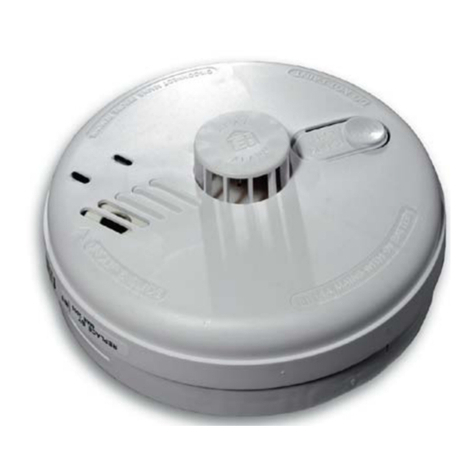Network Technologies ENVIROMUX-SDS-120V User manual

MAN180 REV 11/6/12
ENVIROMUX-SDS-120V
120V Wire-In Smoke Detector
Used in Conjunction with
ENVIROMUX-RLY-SDS120V
Smoke Alarm Relay Module
Installation and Operation Manual
ENVIROMUX-SDS-120V
E
NVIROMUX-RLY-SDS120V
(Sold Separately)
ENVIROMUX®Series

MAN180 REV 11/6/12
Installation with Server Environment Monitoring System
The ENVIROMUX-SDS-120V 120V Wire-in Smoke Detector and ENVIROMUX-RLY-SDS120V relay module can be installed with
connection to an ENVIROMUX-SEMS-16, ENVIROMUX-SEMS-16U or ENVIROMUX-2D/ -5D/-16D Server Environment
Monitoring System(SYSTEM). When installed in this way, the Smoke Detector will be able to cause the SYSTEM to provide
alerts via email, Syslog, SNMP traps, SMS text messages and front panel LEDs indications.
Follow the diagrams below to install to a SYSTEM.
See the pages that follow for more on the installation, operation and maintenance of the ENVIROMUX-SDS-120V Wire-In Smoke
Detector.

A.C. Wire-in Single and/or Multiple Station (up to 24 Devices) Ionization
Smoke Alarm with 9 Volt Battery Back Up and SMART HUSHTM Control to
temporarily silence nuisance alarms.
Thank you for purchasing this smoke alarm. It is an important part of your family’s
home safety plan. You can trust this product to provide the highest quality safety
protection. We know you expect nothing less when the lives of your family are at
stake. Kidde alarms and accessories CAN ONLY BE interconnected with other Kidde
alarms and accessories as well as specified brands and models of interconnect com-
patible alarms. Connection of Kidde products to a non-specified manufacturer’s
interconnect system, or connection with non-specified equipment from another
manufacturer into an existing Kidde system could result in nuisance alarming, fail-
ure to alarm, or damage to one or all of the devices in the interconnect system.
Refer to the User’s Guide supplied with each Kidde product for interconnect com-
patible models, brands, and devices. Refer to the wiring instructions in section 3 for
NFPA initiating device limits.
For model: i12060
Manual P/N 820-0394-EN Rev. D
i12060
For your convenience, write down the following information. If you call
our Consumer Hotline, these are the first questions you will be asked.
Smoke Alarm Model Number
(located on back of alarm):
Date Code (located on back of alarm): The
National Fire Protection Association (NFPA)
and the manufacturer recommend replacing
this alarm ten years from the date code.
Date of Purchase:
Where Purchased:
Smoke Alarm User’s Guide

This alarm detects products of combustion using the ionization technique. It
contains 0.9 microcurie of Americium 241, a radioactive material (see Section 9).
Distributed under U.S. NRC License No. 32-23858-01E. Manufactured in compli-
ance with U.S. NRC safety criteria in 10 CFR 32.27. The purchaser is exempt
from any regulatory requirements. Do not try to repair the smoke alarm yourself.
Refer to the instructions in Section 12 for service.
WARNING! REMOVAL OF THE SMOKE ALARM BATTERY AND DISCONNECT-
ING or LOSS OF A.C. POWER WILL RENDER THE SMOKE ALARM INOPERATIVE.
ELECTRICAL RATING: 120 VAC, 60HZ, 80mA maximum per alarm (maximum
80mA for originating unit with 24 devices interconnected).
IMPORTANT! READ ALL INSTRUCTIONS BEFORE INSTALLATION AND KEEP
THIS MANUAL NEAR THE ALARM FOR FUTURE REFERENCE.
CONTENTS OF THIS MANUAL
1 -- RECOMMENDED LOCATIONS FOR SMOKE ALARMS
2 -- LOCATIONS TO AVOID
3 -- INSTALLATION INSTRUCTIONS
4 -- OPERATION AND TESTING
5 -- NUISANCE ALARMS
6 -- MAINTENANCE
7 -- LIMITATIONS OF SMOKE ALARMS
8 -- GOOD SAFETY HABITS
9 -- NRC INFORMATION
10 -- NFPA PROTECTION STANDARD 72
11 -- CALIFORNIA STATE FIRE MARSHAL REQUIRED INFORMATION
12 -- SERVICE AND WARRANTY
1. RECOMMENDED LOCATIONS FOR ALARMS
•Locate the first alarm in the immediate area of the bedrooms. Try to monitor
the exit path as the bedrooms are usually farthest from the exit. If more than
one sleeping area exists, locate additional alarms in each sleeping area.
•Locate additional alarms to monitor any stairway as stairways act like chim-
neys for smoke and heat.
•Locate at least one alarm on every floor level.
•Locate an alarm in every bedroom.
•Locate an alarm in every room where electrical appliances are operated (i.e.
portable heaters or humidifiers).

FIGURE 1
FIGURE 2 FIGURE 3
•Locate an alarm in every room where someone sleeps with the door closed.
The closed door may prevent an alarm not located in that room from waking
the sleeper.
•Smoke, heat, and combustion products rise to the ceiling and spread horizon-
tally. Mounting the smoke alarm on the ceiling in the center of the room
places it closest to all points in the room. Ceiling mounting is preferred in
ordinary residential construction.
•For mobile home installation, select locations carefully to avoid thermal barri-
ers that may form at the ceiling. For more details, see MOBILE HOME INSTAL-
LATION below.
•When mounting an alarm on the ceiling, locate it at a minimum of 4” (10 cm)
from the side wall (see FIGURE 1).
•When mounting the alarm on the wall, use an inside wall with the top edge
of the alarm at a minimum of 4” (10 cm) and a maximum of 12” (30.5 cm)
below the ceiling (see FIGURE 1).
•Put smoke alarms at both ends of a bedroom hallway or large room if the
hallway or room is more than 30 feet (9.1 m) long.
•Install Smoke Alarms on sloped, peaked or cathedral ceilings at or within 3ft
(0.9m) of the highest point (measured horizontally). NFPA 72 states: “Smoke
alarms in rooms with ceiling slopes greater than 1 foot in 8 feet (.3m in 2.4
m) horizontally shall be located on the high side of the room.” NFPA 72
states: “A row of detectors shall be spaced and located within 3 ft (0.9m) of
the peak of the ceiling measured horizontally” (see FIGURE 3).

MOBILE HOME INSTALLATION
Modern mobile homes have been designed and built to be energy efficient.
Install smoke alarms as recommended above (refer to RECOMMENDED LOCA-
TIONS and FIGURES 1 and 2).
In older mobile homes that are not well insulated compared to present stan-
dards, extreme heat or cold can be transferred from the outside to the inside
through poorly insulated walls and roof. This may create a thermal barrier
which can prevent the smoke from reaching an alarm mounted on the ceiling.
In such units, install the smoke alarm on an inside wall with the top edge of the
alarm at a minimum of 4” (10 cm) and a maximum of 12” (30.5 cm) below the
ceiling (see FIGURE 1).
If you are not sure about the insulation in your mobile home, or if you notice
that the outer walls and ceiling are either hot or cold, install the alarm on an
inside wall. For minimum protection, install at least one alarm close to the bed-
rooms. For additional protection, see SINGLE FLOOR PLAN in FIGURE 2.
WARNING: TEST YOUR SMOKE ALARM OPERATION AFTER R.V. OR
MOBILE HOME VEHICLE HAS BEEN IN STORAGE, BEFORE EACH TRIP AND
AT LEAST ONCE A WEEK DURING USE.
2. LOCATIONS TO AVOID
•In the garage. Products of combustion are present when you start your auto-
mobile.
•Less than 4” (10cm) from the peak of an “A” frame type ceiling.
•In an area where the temperature may fall below 40ºF or rise above 100ºF,
such as garages and unfinished attics.
•In dusty areas. Dust particles may cause nuisance alarm or failure to alarm.
•In very humid areas. Moisture or steam can cause nuisance alarms.
•In insect-infested areas.
•Smoke alarms should not be installed within3ft (.9m) of the following: the
door toakitchen, the door toabathroom containingatub or shower, forced
air supply ducts used for heating or cooling, ceiling or whole house ventilating
fans, or other high air flow areas.
•Kitchens. Normal cooking may cause nuisance alarms. If a kitchen alarm is
desired, it should have an alarm silence feature or be a photoelectric type.
•Near fluorescent lights. Electronic “noise” may cause nuisance alarms.
•Smoke alarms are not to be used with detector guards unless the combination
(alarm and guard) has been evaluated and found suitable for that purpose.

3. INSTALLATION INSTRUCTIONS
WIRING REQUIREMENTS
•This smoke alarm should be installed on a U.L. listed or recognized junction
box. All connections should be made by a qualified electrician and all wiring
used shall be in accordance with articles 210 and 300.3(B) of the U.S. National
Electrical Code ANSI/NFPA 70, NFPA 72 and/or any other codes having jurisdic-
tion in your area. The multiple station interconnect wiring to the alarms must
be run in the same raceway or cable as the AC power wiring. In addition, the
resistance of the interconnect wiring shall be a maximum of 10 ohms.
•The appropriate power source is 120 Volt A.C. Single Phase supplied from a
non-switchable circuit which is not protected by a ground fault interrupter.
•WARNING: This alarm cannot be operated from power derived from a square
wave, modified square wave or modified sine wave inverters. These types of
inverters are sometimes used to supply power to the structure in off grid
installations, such as solar or wind derived power sources. These power
sources produce high peak voltages that will damage the alarm.
WIRING INSTRUCTIONS FOR A.C. QUICK CONNECT HARNESS
CAUTION! TURN OFF THE MAIN POWER TO THE CIRCUIT BEFORE WIRING
THE ALARM.
•For alarms that are used as single station, DO NOT CONNECT THE RED WIRE
TO ANYTHING. Leave the red wire insulating cap in place to make certain that
the red wire cannot contact any metal parts or the electrical box.
•When alarms are interconnected, all interconnected units must be powered
from a single circuit.
•A maximum of 24 Kidde devices may be interconnected in a multiple station
arrangement. The interconnect system should not exceed the NFPA intercon-
nect limit of 12 smoke alarms and/or 18 alarms total (smoke, heat, carbon
monoxide, etc.). With 18 alarms interconnected, it is still possible to intercon-
nect up to a total of 6 remote signaling devices and/or relay modules.
•When mixing models which have battery backup (i12040, i12060, i12080,
1275, 1276, 1285, 1296, PE120, PI2000, KN-COSM-IB, RF-SM-ACDC,
HD135F, KN-COB-IC, KN-COP-IC) with models without battery backup, (i1220,
1235, KN-COSM-I, KN-COB-ICB, KN-COP-ICB, 120X, SM120X,CO120X,
SL177i) be advised that the models without battery backup will not respond
during an AC power failure.
•For more information about compatible interconnect units and their function-
ality in an interconnect system, visit our web site at: www.Kidde.com

•The maximum wire run distance between the first and last unit in an intercon-
nected system is 1000 feet.
•Figure 4 illustrates interconnection wiring. Improper connection will result in
damage to the alarm, failure to operate, or a shock hazard.
•Make certain alarms are wired to a continuous (non-switched) power line.
NOTE: Use standard UL listed household wire (as required by local codes) avail-
able at all electrical supply stores and most hardware stores.
FIGURE 4 INTERCONNECT WIRING DIAGRAM
WIRES ON ALARM HARNESS CONNECTED TO
Black Hot Side of A.C. Line
eniL.C.AfoediSlartueNetihW
rehtOfo)seriWdeR(seniLtcennocretnIdeR
Units in the Multiple Station Set up
BATTERY INSTALLATION
See MAINTENANCE (Section 6) for battery installation.
CAUTION! THIS UNIT WILL NOT FUNCTION WITHOUT A PROPERLY
INSTALLED BATTERY, AND IS EQUIPPED WITH A BATTERY LOCKOUT FEA-
TURE WHICH PREVENTS THE BATTERY CARRIER FROM CLOSING IF A BAT-
TERY IS NOT INSTALLED CORRECTLY.
MOUNTING INSTRUCTIONS
CAUTION: THIS UNIT IS SEALED. THE COVER IS NOT
REMOVABLE!
CAUTION: WHEN WALL MOUNTING: UNIT MUST BE
MOUNTED SO THAT THE BATTERY BOX FACES
DOWN! (SEE FIGURE 5). INCORRECT ORIENTATION
OF WALL MOUNTED SMOKE ALARMS WILL
DECREASE OPERATIONAL EFFECTIVENESS.
FUSE OR CIRCUIT BREAKER
RED
BLACK
WHITE
CONNECTOR
RED
BLACK
WHITE
CONNECTOR
First
Alarm
Additional
Alarm Optional
Accessory
Additional
Alarm
Kidde
Relay Module
SM120X
FIGURE 5

1. Remove the trim ring from the back of the alarm by holding the trim ring and
twisting the alarm counter-clockwise.
2. After selecting the proper smoke alarm location as described in Section 1 and
wiring the AC Quick Connector as described in the WIRING INSTRUCTIONS,
attach the trim ring to the electrical box (see Figure 6). To ensure aesthetic align-
ment of the alarm with the hallway or wall, the “A” line on the mounting
bracket must be parallel with the hallway when ceiling mounted, or horizontal
when wall mounted.
3. Pull the AC QUICK CONNECTOR through the center hole in the mounting
bracket and secure the bracket, making sure that the mounting screws are posi-
tioned in the small ends of the keyholes before tightening the screws.
4. Plug the AC QUICK CONNECTOR into the back of the alarm (see Figure 7),
making sure that the locks on the connector snap into
place. Then push the excess wire back into the electrical
box through the hole in the center of the mounting
bracket.
5. Install the alarm on the mounting bracket and rotate
the alarm clockwise until the alarm ratchets into place
(this ratcheting function allows for aesthetic alignment).
NOTE: The alarm will mount to the bracket in 4 posi-
tions (every 90 degrees). When wall mounting, make
sure the battery box is at the bottom of the unit. (see Figure 5).
6. Pull the Battery Pull Tab (yellow tab protruding from the unit) completely out
of the unit. This will automatically connect the battery.
7. Test the unit to ensure proper operation by pressing the Test/Hush Button for
a minimum of 5 seconds. (All interconnected, battery backed up, alarms should
respond).
CAUTION: Due to the loudness (85 decibels) of the alarm, always stand
an arms length away from the unit when testing.
When
mounting in
a hallway,
the “A” line
should be
parallel with
the hallway.
When wall mounting,
the “A” line should be
horizontal.
Alignment Marks
Remove
Install
AA
FIGURE 6
FIGURE 7

8. Turn on the AC power. The green Power On Indicator should be lit when the
alarm is operating from AC power. Confirm unit operation by pressing the
Test/Hush button.
TAMPER RESIST FEATURES
Smoke Alarm Tamper Resist Feature
This alarm has a tamper resist feature, which helps prevent someone from
removing the unit from the mounting bracket. When used in conjunction with
the Battery Carrier Tamper Resist Feature, it can be very effective in preventing
smoke alarm tampering and battery removal.
Activate the smoke alarm tamper resist feature by breaking off the four posts in
the square holes in the mounting bracket (see Figure 8A). When the posts are
broken off, the tamper resist tab on the base is allowed to engage the mounting
bracket. Rotate the alarm onto the mounting bracket until you hear the tamper
resist tab snap into place, locking the alarm on the mounting bracket. Using the
tamper resist feature will help deter children and others from removing the
alarm from the bracket. NOTE: To remove the alarm when the tamper resist tab
is engaged, press down on the tamper resist tab, and rotate the alarm off the
bracket (see Figure 8B).
Battery Carrier Tamper Resist Feature
This alarm has a battery carrier tamper resist feature, which helps prevent the
battery carrier from being opened. This feature is effective in preventing the
removal of the battery from this device (which will render the unit inoperable
during the loss of AC power).
To activate the battery carrier tamper resist feature, remove the unit from the
trim plate, disconnect the AC quick connector and locate the small cut-out in
the middle of the product label on the back of the unit. With a small screwdriv-
er, or similar tool, slide the switch towards the top of the label. (see Figure 9)
The tamper resist feature is now active and the battery carrier can not be
opened until the tamper resist feature is deactivated.
FIGURE 8B
Locations
of Posts
AA
FIGURE 8A

NOTE: Before activating the battery carrier tamper resist
feature, make sure a fresh battery is installed in the unit
and that the battery carrier is properly closed. If the bat-
tery carrier tamper resist feature is activated while the
battery carrier is open, the battery carrier will not close
and the unit will be inoperable during the loss of AC
power.
To deactivate the battery carrier tamper resist, in order
to change the smoke alarm battery, remove the unit
from the trim plate (see Smoke Alarm Tamper Resist Feature if activated), discon-
nect the AC quick connector and locate the small cut-out in the middle of the
product label. Using a screwdriver, or similar tool, slide the switch towards the
bottom of the product label. The battery carrier can now be opened and the
battery changed.
4. OPERATION AND TESTING
OPERATION: The smoke alarm is operating once A.C. power is applied, fresh
batteries are installed and testing is complete. When the smoke alarm ionization
chamber senses products of combustion, the horn will sound a loud (85db) tem-
poral alarm until the sensing chamber is cleared of smoke particles.
SMART HUSHTM CONTROL: The “HUSH” feature has the capability of temporarily
desensitizing the alarm circuit for up to 8 minutes. This feature is to be used
only when a known alarm condition, such as smoke from cooking, activates the
alarm. The HUSH feature cannot be activated unless the smoke alarm is sound-
ing in the originating alarm mode.The smoke alarm is desensitized by pushing
the “TEST/HUSH” button on the smoke alarm cover. If the smoke is not too
dense, the alarm will silence immediately. The red LED will illuminate for 1.5 sec-
onds every 8 seconds while in hush. This indicates that the alarm is in a tem-
porarily desensitized condition. The smoke alarm will automatically reset after
approximately 8 minutes and sound the alarm if particles of combustion are still
present. The “HUSH” feature can be used repeatedly until the air has been
cleared of the condition causing the alarm. Pushing the Test/Hush button on the
alarm will end the hush period.
NOTE: DENSE SMOKE WILL OVERRIDE THE HUSH CONTROL FEATURE AND
SOUND A CONTINUOUS ALARM.
CAUTION: BEFORE USING THE ALARM HUSH FEATURE, IDENTIFY THE
SOURCE OF THE SMOKE AND BE CERTAIN A SAFE CONDITION EXISTS.
LED INDICATORS: This smoke alarm is equipped with red and green LED indica-
tors. The green LED (when illuminated) indicates the presence of AC power.
FIGURE 9

The red LED has four modes of operation:
Standby Condition: The red LED will flash every 30-40 seconds to indicate
that the smoke alarm is operating properly.
Alarm Condition: When the alarm senses products of combustion and
goes into alarm, the red LED will flash one flash per
second. The flashing LED and pulsating alarm will
continue until the air is cleared.
WHEN UNITS ARE INTERCONNECTED, only the red LED
of the alarm which senses the smoke or is being tested
(the originating unit) will flash. All other units in the
interconnect system will sound an alarm but their red
LED’s will NOT be flashing.
Alarm Memory: This smoke alarm is equipped with an alarm memory,
which provides a visual indication when an alarm has
been activated. The red LED will illuminate for about 1.5
seconds every 16 seconds to indicate the memory
condition. The memory will remain activated until
pushing the Test/Hush Button resets it. The memory will
also reset if the battery voltage drops to 8 volts. In an
inteconected installation only the memory of the
originating alarm will be activated.
Hush®mode: The red LED will illuminate for 1.5 seconds every 8
seconds, indicating the smoke alarm is in the Hush®
mode.
TESTING: Test by pushing the Test/Hush button on the cover and hold it down
for a minimum of 5 seconds. This will sound the alarm if all the electronic cir-
cuitry, horn and battery are working. In an interconnected installation all inter-
connected alarms should sound when the test feature on any one of the inter-
connected alarms is activated. If no alarm sounds, check the fuse or circuit
breaker supplying power to the alarm circuit. If the alarm still does not sound,
the unit has defective batteries or other failure. DO NOT use an open flame to
test your alarm, you could damage the alarm or ignite combustible materials
and start a structure fire.
TEST THE ALARM WEEKLY TO ENSURE PROPER OPERATION. Erratic or low sound
coming from your alarm may indicate a defective alarm, and it should be
returned for service (see Section 12).

5. NUISANCE ALARMS
Smoke alarms are designed to minimize nuisance alarms. Cigarette smoke will
not normally set off the alarm, unless the smoke is blown directly into the alarm.
Combustion particles from cooking may set off the alarm if the alarm is located
close to the cooking area. Large quantities of combustible particles are generat-
ed from spills or when broiling. Using the fan on a range hood which vents to
the outside (non-recirculating type) will also help remove these combustible
products from the kitchen.
Model i12060 has a “HUSH” feature that is extremely useful in a kitchen area or
other areas prone to nuisance alarms. For more information, refer to Section 4
OPERATION AND TESTING.
If the alarm does sound, check for fires first. If a fire is discovered, get out and
call the fire department. If no fire is present, check to see if one of the reasons
listed in Section 2 may have caused the alarm.
6. MAINTENANCE
ALARM REMOVAL
IF SMOKE ALARM TAMPER RESIST FEATURE HAS BEEN ACTIVATED, REFER
TO SMOKE ALARM TAMPER RESIST FEATURE IN SECTION 3 FOR REMOVAL
INSTRUCTIONS.
To remove the alarm from the trim ring, rotate the alarm counter clockwise in the
direction of the "OFF" arrow on the cover. To disconnect the A.C. power harness,
squeeze the locking arms on the sides of the Quick Connector while pulling the
connector away from the bottom of the alarm (see Section 3, Figure 7).
BATTERY INSTALLATION AND REMOVAL
Note: If battery carrier tamper resist feature has been activated it will need to
be deactivated in order to change the battery. Refer to section 3 “Battery
Carrier Tamper Resist Feature” for instructions.
To replace or install the batteries press down on the battery carrier and then
release to allow the carrier to pop open. The battery can then be pulled out of
the carrier. When installing a new battery into the carrier, make sure the battery
terminals are exposed and that the polarity matches the markings printed on the
battery carrier. Completely press the battery carrier down into the alarm and
release, the battery carrier will lock into the closed position.
A missing or improperly installed battery will prevent the battery carrier from
closing and result in improper alarm operation.

This smoke alarm uses a 9V carbon zinc battery (alkaline and lithium batteries
may also be used). A fresh battery should last for one year under normal operat-
ing conditions.
This alarm has a low/missing battery monitor circuit which will cause the alarm
to “chirp” approximately every 30-40 seconds for a minimum of seven (7) days
when the battery gets low.Replace the battery when this condition occurs.
NOTE: Low/missing battery monitor circuit WILL cause the unit to chirp while
replacing the battery. This function will cease once the new battery has been
installed. To avoid this “chirp” the unit can be removed from the base and dis-
connected from the AC power when replacing the battery, but it is not necessary.
USE ONLY THE FOLLOWING 9 VOLT BATTERIES FOR SMOKE ALARM
REPLACEMENT.
Carbon-zinc type EVEREADY 1222; GOLD PEAK 1604P OR 1604S
Alkaline type ENERGIZER 522; DURACELL MN1604 OR MX1604; GOLD
PEAK 1604A PANASONIC 6AM6, 6AM-6, 6AM-6PI,
6AM6X, AND 6LR61 (GA)
Lithium type ULTRALIFE U9VL-J
NOTE: WEEKLY TESTING IS REQUIRED!
WARNING! BE SURE TO FOLLOW BATTERY INSTALLATION INSTRUCTIONS
PRINTED ON THE BACK OF THE ALARM AND USE ONLY THE BATTERIES
SPECIFIED. USE OF DIFFERENT BATTERIES MAY HAVE A DETRIMENTAL
EFFECT ON THE SMOKE ALARM.
CLEANING YOUR ALARM
YOUR ALARM SHOULD BE CLEANED AT LEAST ONCE A YEAR
To clean your alarm, remove it from the mounting bracket as outlined in the
beginning of this section. You can clean the interior of your alarm (sensing
chamber) by using compressed air or a vacuum cleaner hose and blowing or
PRESS OPEN INSERT

vacuuming through the openings around the perimeter of the alarm. The out-
side of the alarm can be wiped with a damp cloth. After cleaning, reinstall your
alarm, verify the green LED is on and test your alarm by using the Test/Hush
Button. If cleaning does not restore the alarm to normal operation the alarm
should be replaced.
7. LIMITATIONS OF SMOKE ALARMS
WARNING: PLEASE READ CAREFULLY AND THOROUGHLY
•NFPA 72 states: Life safety from fire in residential occupancies is based primari-
ly on early notification to occupants of the need to escape, followed by the
appropriate egress actions by those occupants. Fire warning systems for
dwelling units are capable of protecting about half of the occupants in poten-
tially fatal fires. Victims are often intimate with the fire, too old or young, or
physically or mentally impaired such that they cannot escape even when
warned early enough that escape should be possible. For these people, other
strategies such as protection-in-place or assisted escape or rescue are neces-
sary.
•Smoke alarms are devices that can provide early warning of possible fires at a
reasonable cost; however, alarms have sensing limitations. Ionization sensing
alarms may detect invisible fire particles (associated with fast flaming fires)
sooner than photoelectric alarms. Photoelectric sensing alarms may detect visi-
ble fire particles (associated with slow smoldering fires) sooner than ionization
alarms. Home fires develop in different ways and are often unpredictable. For
maximum protection, Kidde recommends that both Ionization and
Photoelectric alarms be installed.
•A battery powered alarm must have a battery of the specified type, in good con-
dition and installed properly.
•A.C. powered alarms (without battery backup) will not operate if the A.C.
power has been cut off, such as by an electrical fire or an open fuse.
•Smoke alarms must be tested regularly to make sure the batteries and the
alarm circuits are in good operating condition.
•Smoke alarms cannot provide an alarm if smoke does not reach the alarm.
Therefore, smoke alarms may not sense fires starting in chimneys, walls, on
roofs, on the other side of a closed door or on a different floor.
•If the alarm is located outside the bedroom or on a different floor, it may not
wake up a sound sleeper.

•The use of alcohol or drugs may also impair one’s ability to hear the smoke
alarm. For maximum protection, a smoke alarm should be installed in each
sleeping area on every level of a home.
•Although smoke alarms can help save lives by providing an early warning of a
fire, they are not a substitute for an insurance policy. Home owners and
renters should have adequate insurance to protect their lives and property.
8. GOOD SAFETY HABITS
DEVELOP AND PRACTICE A PLAN OF ESCAPE
•Install and maintain Fire extinguishers on every level of the home and in the
kitchen, basement and garage. Know how to use a fire extinguisher prior to
an emergency.
•Make a floor plan indicating all doors and windows and at least two (2)
escape routes from each room. Second story windows may need a rope or
chain ladder.
•Have a family meeting and discuss your escape plan, showing everyone what
to do in case of fire.
•Determine a place outside your home where you all can meet if a fire occurs.
•Familiarize everyone with the sound of the smoke alarm and train them to
leave your home when they hear it.
•Practice a fire drill at least every six months, including fire drills at night.
Ensure that small children hear the alarm and wake when it sounds. They
must wake up in order to execute the escape plan. Practice allows all occu-
pants to test your plan before an emergency. You may not be able to reach
your children. It is important they know what to do.
•Current studies have shown smoke alarms may not awaken all sleeping indi-
viduals, and that it is the responsibility of individuals in the household that are
capable of assisting others to provide assistance to those who may not be
awakened by the alarm sound, or to those who may be incapable of safely
evacuating the area unassisted.
WHAT TO DO WHEN THE ALARM SOUNDS
•Alert small children in the home.
•Leave immediately by your escape plan. Every second counts, so don’t waste
time getting dressed or picking up valuables.

•In leaving, don’t open any inside door without first feeling its surface. If hot,
or if you see smoke seeping through cracks, don’t open that door! Instead,
use your alternate exit. If the inside of the door is cool, place your shoulder
against it, open it slightly and be ready to slam it shut if heat and smoke rush
in.
•Stay close to the floor if the air is smoky. Breathe shallowly through a cloth,
wet if possible.
•Once outside, go to your selected meeting place and make sure everyone is
there.
•Call the fire department from your neighbor’s home - not from yours!
•Don’t return to your home until the fire officials say that it is all right to do so.
There are situations where a smoke alarm may not be effective to protect
against fire as stated in the NFPA Standard 72. For instance:
a) smoking in bed
b) leaving children home alone
c) cleaning with flammable liquids, such as gasoline
9. NRC INFORMATION
Ionization type smoke alarms use a very small amount of a radioactive element
in the sensing chamber to enable detection of visible and invisible combustion
products. The radioactive element is safely contained in the chamber and
requires no adjustments or maintenance. This smoke alarm meets or exceeds all
government standards. It is manufactured and distributed under license from
the U.S. Nuclear Regulatory Commission.
10. NFPA REQUIRED PROTECTION
The National Fire Protection Association’s Standard 72 provides the following
information:
Smoke Detection – Where required by applicable laws, codes, or standards for
the specified occupancy, approved single- and multiple-station smoke alarms
shall be installed as follows: (1) In all sleeping rooms Exception: Smoke alarms
shall not be required in sleeping rooms in existing one- and two-family dwelling
units. (2) Outside of each separate sleeping area, in immediate vicinity of the
sleeping rooms. (3) On each level of the dwelling unit, including basements
Exception: In existing one- and two-family dwelling units, approved smoke
alarms powered by batteries are permitted.

Smoke Detection – Are More Smoke Alarms Desirable? The required number of
smoke alarms might not provide reliable early warning protection for those areas
separated by a door from the areas protected by the required smoke alarms. For
this reason, it is recommended that the householder consider the use of addi-
tional smoke alarms for those areas for increased protection. The additional
areas include the basement, bedrooms, dining room, furnace room, utility room,
and hallways not protected by the required smoke alarms. The installation of
the smoke alarms in the kitchen, attic (finished or unfinished), or garage is nor-
mally not recommended, as these locations occasionally experience conditions
that can result in improper operation.
This equipment should be installed in accordance with the National Fire
Protection Association’s Standard 72 (NFPA, Batterymarch Park, Quincy, MA
02269).
NOTIFY YOUR LOCAL FIRE DEPARTMENT AND INSURANCE COMPANY OF YOUR
SMOKE ALARM INSTALLATION.
11. CAUTION (AS REQUIRED BY THE CALIFORNIA STATE FIRE
MARSHAL)
“Early warning fire detection is best achieved by the installation of fire detection
equipment in all rooms and areas of the household as follows.Asmoke alarm
installed in each separate sleeping area (in the vicinity of, but outside of the bed-
rooms), and heat or smoke detectors in the living rooms, dining rooms, bed-
rooms, kitchens, hallways, attics, furnace rooms, closets, utility and storage
rooms, basements and attached garages.”
12. SERVICE AND WARRANTY
If after reviewing this manual you feel that your smoke alarm is defective in any
way, do not tamper with the unit.
Return it for servicing to: KIDDE, 1016 Corporate Park Dr., Mebane, NC 27302.
1-800-880-6788 (See Warranty for in-warranty returns).

FIVE YEAR LIMITED WARRANTY
KIDDE Safety warrants to the original purchaser that the enclosed smoke alarm (but not
the battery) will be free from defects in material and workmanship or design under nor-
mal use and service for a period of five years from the date of purchase. The obligation
of KIDDE Safety under this warranty is limited to repairing or replacing the smoke alarm
or any part which we find to be defective in material, workmanship or design, free of
charge to the customer, upon sending the smoke alarm with proof of date of purchase,
postage and return postage prepaid, to Warranty Service Department, KIDDE Safety,
1016 Corporate Park Dr., Mebane, NC 27302.
This warranty shall not apply to the smoke alarm if it has been damaged, modified,
abused or altered after the date of purchase or if it fails to operate due to improper
maintenance or inadequate A.C. or D.C. electrical power.
THE LIABILITY OF KIDDE SAFETY OR ANY OF ITS PARENT OR SUBSIDIARY CORPORA-
TIONS ARISING FROM THE SALE OF THIS SMOKE ALARM OR UNDER THE TERMS OF
THIS LIMITED WARRANTY SHALL NOT IN ANY CASE EXCEED THE COST OF REPLACE-
MENT OF SMOKE ALARM AND, IN NO CASE, SHALL KIDDE SAFETY OR ANY OF ITS
PARENT OR SUBSIDIARY CORPORATIONS BE LIABLE FOR CONSEQUENTIAL LOSS OR
DAMAGES RESULTING FROM THE FAILURE OF THE SMOKE ALARM OR FOR BREACH OF
THIS OR ANY OTHER WARRANTY, EXPRESS OR IMPLIED, EVEN IF THE LOSS OR DAM-
AGE IS CAUSED BY THE COMPANY’S NEGLIGENCE OR FAULT.
Since some states do not allow limitations on the duration of an implied warranty or do
not allow the exclusion or limitation of incidental or consequential damages, the above
limitations or exclusions may not apply to you. While this warranty gives you specific
legal rights, you may also have other rights which vary from state to state.
Also, KIDDE Safety makes no warranty, express or implied, written or oral, including
that of merchantability or fitness for any particular purpose, with respect to the battery.
The above warranty may not be altered except in writing signed by both parties hereto.
QUESTIONS OR FOR MORE INFORMATION
Call our Consumer Hotline at 1-800-880-6788 or contact
us at our website at www.kidde.com
Kidde 1016 Corporate Park Drive, Mebane, NC 27302

SM120X
RELAY / POWER SUPPLY MODULE
READ INSTRUCTIONS CAREFULLY AND COMPLETELY BEFORE INSTALLING.
Electrical Rating: 120V AC 60 HZ 0.08 AMP
Contact Rating: 10 AMPS @ 120 VAC
NON INDUCTIVE
5 AMPS @ 30 VDC
DC Output: 5 MA Max. (CURRENT LIMITED)
DESCRIPTION:
This module is only activated by a smoke alarm interconnect signal.
The relay portion of this module can be used to activate auxiliary warning devices
such as external bells and sirens, hallway or stairwell lighting. It provides isolated,
(no internal connection to 120 volts AC) normally open, and normally closed
contacts.
The power supply portion can be used to connect spot type heat detectors (Rate of
rise or combined rate of rise and fixed temperature only) and manual pull
stations with interconnected multiple station alarms.
WARNING! Alarm and module wiring must conform to the electrical codes and local
codes in your area. In USA, it includes Article 760 of the U.S. National Electrical
Code, and NFPA No. 72-2.
All wiring should be performed by a licensed electrician. The module should be
installed in a UL listed junction box that has sufficient volume for proper installation.
The electrical circuit used to power the alarms and the module must be a 120 volt ac
60hz circuit which cannot be turned off by a switch or a ground fault interrupter, it
must be on 24 hours a day. Since this module is 120 volt AC powered, it
will not function during an AC power failure, even if it is being used with the
model 1275, 1275CA, 1285, 1285CA, PE120, PE120CA, PI 2000, PI2000CA,
KN-COSM-IB, KN-COSM-IBCA, HD135F, and HD135FCA, alarms which have
battery backup power.
IMPORTANT: Whenever alarms and modules are interconnected they must be
powered from a single circuit. When wiring the module remote from the alarm use
CSA listed #18 AWG wire or larger as required by codes in your area. Do not use
more than 1000 feet of wire between the first and last device in the multi station
system.
INSTALLATION INSTRUCTIONS:
This module should be installed in a UL listed junction box. All connections should
be made by a qualified electrician in accordance with the requirements of the
national electrical code and/or any other local codes having jurisdiction in your area.
Turn off the main power to the circuit. If you are also installing smoke alarms,
heat alarms, or CO alarms, wire them according to their specific owner’s manual.
Refer to the typical installation diagrams (Figures 1-4) included in this manual for
your specific application.
Connections on the Relay /Power Supply Module:
Black Wire AC Hot
White Wire AC Neutral
Red Wire Interconnect Signal
Blue Wire Common Contact
Yellow Wire Normally Closed Contact
Orange Wire Normally Open Contact
Gray Wire 9-Volt DC Output (5MA Max.)
After all connections are made, place the module inside a UL listed junction box,
where the alarm is installed, or in a remote location and use the appropriate
electrical box cover.
CAUTION: The model SM120X should not be used to connect groups of alarms to a
fire alarm panel or to interconnect groups of fire alarms together.
Residential alarms do not latch in the alarm condition and they are self-resetting. If
an alarm connected to a module has the test button pushed or the alarm momentarily
activates, it will activate the module for as long as the unit is in alarm. If more than
one alarm is connected to the module and the module is tied to a control panel there
will be no way of knowing which unit caused the alarm.
The model SM120X module is for use with the following interconnectable models:
Smoke Alarms: 1235, 1235CA, 1275, 1275CA, 1285, 1285CA, PE120, PE120CA,
PI2000, and PI2000CA, CO/ Smoke Combo alarms: KN-COSM-IB and KN-COSM-
IBCA, and Heat Alarms, HD135F, and HD135FCA, all with red interconnect wires.
Each module is equivalent to one interconnect alarm, reduce the maximum number
of interconnect devices by one for each module used. Do not exceed the total
number of devices allowable in the interconnect system, refer to the individual alarm
owners manual for the maximum number of units allowed when interconnecting. Do
not exceed the temperature or humidity limits of +40°F (4,4°C) to 100°F (37,8°C)
and 90% relative humidity for either the relay module or the alarms.
NOTE: Only the Smoke portion of the: KN-COSM-IB and KN-COSM-IBCA combo
alarms will activate this module. If CO alarm models, KN-COB-IC, KN-COP-IC are
included in the interconnect system, they will not activate the SM120X module.
ATTENTION: The wiring connecting the module with the external devices is not
supervised. Be sure to test the operation of all the devices controlling the module or
controlled by the module. Devices controlled by the module can be tested by
pushing the test button on the alarms and verifying that the controlled device
responds in the desired manner.
Devices controlling the module can be tested by activating the device. Test pull
stations and spot type heat detectors after initial installation and each time you test
your alarms. Verify that the pull station and heat detectors sound all your
interconnected alarms.
ATTENTION: Only use spot type heat detectors incorporating a rate of rise
feature, as this type can be tested to validate operation. These detectors should be
tested following the manufacturers recommended procedure. This procedure
typically recommends using a hot air source (hand held hair dryer or heat gun)
directed at the detector from approximately 1 foot away. This will activate the rate of
rise portion of the detector and sound the interconnected alarms.
CAUTION: Remove the hot air source as soon as the alarms sound. This will prevent
activating the fixed temperature portion of the heat detector. The fixed temperature
element is a one-time device. Once activated it will not reset and the detector will
have to be replaced.
ADDITIONAL INSTALLATION INFORMATION: (Figures 1 and 2) If the desired
function is to switch off a device when the alarms sound, connect the yellow wire
(NC) instead of the orange wire (NO) to the supply side of the device. Be sure not to
exceed the relay contact ratings of the module. This module should not be used to
control inductive loads with inrush currents that will exceed the maximum contact ratings.
ONEYEAR LIMITED WARRANTY:
Kidde warrants to the Purchaser that the enclosed module will be free of defects in
material, workmanship or design under normal use and service for a period of one
year from the date of purchase. The obligation to Kidde under this warranty is limited
to repairing or replacing any part which we find to be defective in material,
workmanship, or design, free of charge, to the customer, upon sending the relay
module with proof of date of purchase, postage and return postage prepaid, to
Warranty Service dept. Kidde Safety, 1394 S. Third Street. Mebane, NC 27302 USA.
(1-800-880-6788) This warranty shall not apply to the relay module if it has been
damaged, modified, abused or altered after the date of purchase, or if it fails to
operate due to improper maintenance or inadequate AC electrical power.
The liability of Kidde or any of its parent or subsidiary corporations arising from the
sale of this accessory module or under the terms of this limited warranty shall not in
any case exceed the cost of the replacement of the module and, in no case, shall
Kidde or any of its parent or subsidiary corporations be liable for consequential loss
or damages resulting from the failure of the relay module or for the breach of this or
any other warranties, expressed or implied, even if the loss of damage is caused the
company's negligence or fault.
Since some states/provinces do not allow limitations on the duration of an implied
warranty or do not allow the exclusions or limitations of incidental or consequential
damages the above limitations or exclusions may not apply to you. While this
warranty gives you specific legal rights, you may also have other rights, which vary
from state to state, or province to province. The above warranty may not be altered
except in writing signed by both parties hereto.
Manual P/N 810-1775 Rev. B
This manual suits for next models
1
Table of contents
Popular Smoke Alarm manuals by other brands

Gentex
Gentex 8000 Series installation instructions

Telenot
Telenot HD 1000 Operating and assembly instructions

Polon-Alfa
Polon-Alfa DOP-6001R Installation and maintenance manual
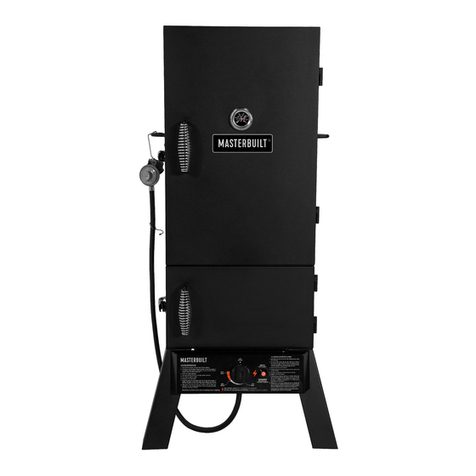
Masterbuilt
Masterbuilt MPS 230S Series user manual

Fire-Lite Alarms
Fire-Lite Alarms D350P Installation and maintenance instructions

Lifesaver
Lifesaver LIF5000 Installation and user manual
